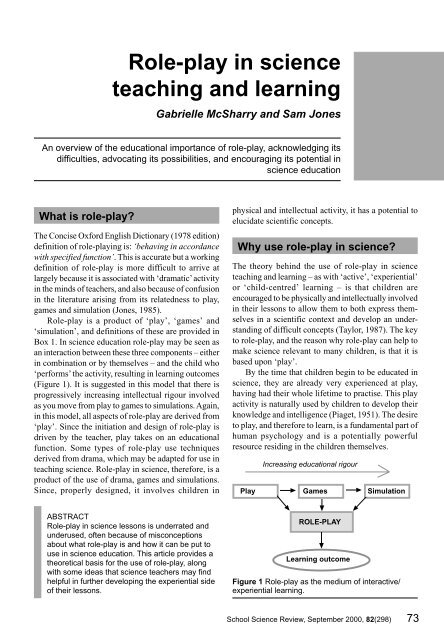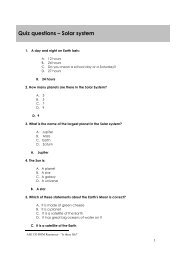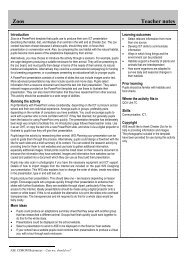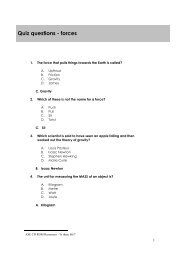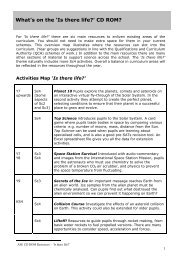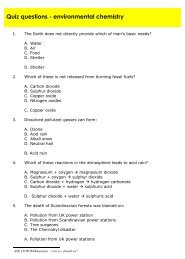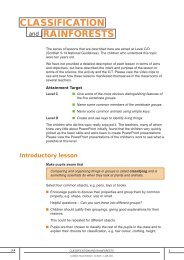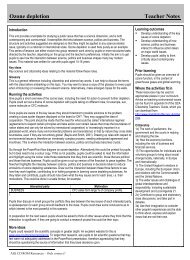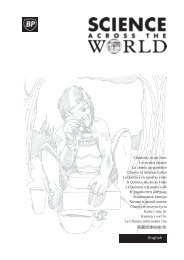Role-play in science teaching and learning - ASE Science Year CD ...
Role-play in science teaching and learning - ASE Science Year CD ...
Role-play in science teaching and learning - ASE Science Year CD ...
You also want an ePaper? Increase the reach of your titles
YUMPU automatically turns print PDFs into web optimized ePapers that Google loves.
McSharry <strong>and</strong> Jones<br />
<strong>Role</strong>-<strong>play</strong> <strong>in</strong> <strong>science</strong> teach<strong>in</strong>g <strong>and</strong> learn<strong>in</strong>g<br />
<strong>Role</strong>-<strong>play</strong> <strong>in</strong> <strong>science</strong><br />
teach<strong>in</strong>g <strong>and</strong> learn<strong>in</strong>g<br />
Gabrielle McSharry <strong>and</strong> Sam Jones<br />
An overview of the educational importance of role-<strong>play</strong>, acknowledg<strong>in</strong>g its<br />
difficulties, advocat<strong>in</strong>g its possibilities, <strong>and</strong> encourag<strong>in</strong>g its potential <strong>in</strong><br />
<strong>science</strong> education<br />
What is role-<strong>play</strong>?<br />
The Concise Oxford English Dictionary (1978 edition)<br />
def<strong>in</strong>ition of role-<strong>play</strong><strong>in</strong>g is: ‘behav<strong>in</strong>g <strong>in</strong> accordance<br />
with specified function’. This is accurate but a work<strong>in</strong>g<br />
def<strong>in</strong>ition of role-<strong>play</strong> is more difficult to arrive at<br />
largely because it is associated with ‘dramatic’ activity<br />
<strong>in</strong> the m<strong>in</strong>ds of teachers, <strong>and</strong> also because of confusion<br />
<strong>in</strong> the literature aris<strong>in</strong>g from its relatedness to <strong>play</strong>,<br />
games <strong>and</strong> simulation (Jones, 1985).<br />
<strong>Role</strong>-<strong>play</strong> is a product of ‘<strong>play</strong>’, ‘games’ <strong>and</strong><br />
‘simulation’, <strong>and</strong> def<strong>in</strong>itions of these are provided <strong>in</strong><br />
Box 1. In <strong>science</strong> education role-<strong>play</strong> may be seen as<br />
an <strong>in</strong>teraction between these three components – either<br />
<strong>in</strong> comb<strong>in</strong>ation or by themselves – <strong>and</strong> the child who<br />
‘performs’ the activity, result<strong>in</strong>g <strong>in</strong> learn<strong>in</strong>g outcomes<br />
(Figure 1). It is suggested <strong>in</strong> this model that there is<br />
progressively <strong>in</strong>creas<strong>in</strong>g <strong>in</strong>tellectual rigour <strong>in</strong>volved<br />
as you move from <strong>play</strong> to games to simulations. Aga<strong>in</strong>,<br />
<strong>in</strong> this model, all aspects of role-<strong>play</strong> are derived from<br />
‘<strong>play</strong>’. S<strong>in</strong>ce the <strong>in</strong>itiation <strong>and</strong> design of role-<strong>play</strong> is<br />
driven by the teacher, <strong>play</strong> takes on an educational<br />
function. Some types of role-<strong>play</strong> use techniques<br />
derived from drama, which may be adapted for use <strong>in</strong><br />
teach<strong>in</strong>g <strong>science</strong>. <strong>Role</strong>-<strong>play</strong> <strong>in</strong> <strong>science</strong>, therefore, is a<br />
product of the use of drama, games <strong>and</strong> simulations.<br />
S<strong>in</strong>ce, properly designed, it <strong>in</strong>volves children <strong>in</strong><br />
physical <strong>and</strong> <strong>in</strong>tellectual activity, it has a potential to<br />
elucidate scientific concepts.<br />
Why use role-<strong>play</strong> <strong>in</strong> <strong>science</strong>?<br />
The theory beh<strong>in</strong>d the use of role-<strong>play</strong> <strong>in</strong> <strong>science</strong><br />
teach<strong>in</strong>g <strong>and</strong> learn<strong>in</strong>g – as with ‘active’, ‘experiential’<br />
or ‘child-centred’ learn<strong>in</strong>g – is that children are<br />
encouraged to be physically <strong>and</strong> <strong>in</strong>tellectually <strong>in</strong>volved<br />
<strong>in</strong> their lessons to allow them to both express themselves<br />
<strong>in</strong> a scientific context <strong>and</strong> develop an underst<strong>and</strong><strong>in</strong>g<br />
of difficult concepts (Taylor, 1987). The key<br />
to role-<strong>play</strong>, <strong>and</strong> the reason why role-<strong>play</strong> can help to<br />
make <strong>science</strong> relevant to many children, is that it is<br />
based upon ‘<strong>play</strong>’.<br />
By the time that children beg<strong>in</strong> to be educated <strong>in</strong><br />
<strong>science</strong>, they are already very experienced at <strong>play</strong>,<br />
hav<strong>in</strong>g had their whole lifetime to practise. This <strong>play</strong><br />
activity is naturally used by children to develop their<br />
knowledge <strong>and</strong> <strong>in</strong>telligence (Piaget, 1951). The desire<br />
to <strong>play</strong>, <strong>and</strong> therefore to learn, is a fundamental part of<br />
human psychology <strong>and</strong> is a potentially powerful<br />
resource resid<strong>in</strong>g <strong>in</strong> the children themselves.<br />
Increas<strong>in</strong>g educational rigour<br />
Play Games Simulation<br />
ABSTRACT<br />
<strong>Role</strong>-<strong>play</strong> <strong>in</strong> <strong>science</strong> lessons is underrated <strong>and</strong><br />
underused, often because of misconceptions<br />
about what role-<strong>play</strong> is <strong>and</strong> how it can be put to<br />
use <strong>in</strong> <strong>science</strong> education. This article provides a<br />
theoretical basis for the use of role-<strong>play</strong>, along<br />
with some ideas that <strong>science</strong> teachers may f<strong>in</strong>d<br />
helpful <strong>in</strong> further develop<strong>in</strong>g the experiential side<br />
of their lessons.<br />
ROLE-PLAY<br />
Learn<strong>in</strong>g outcome<br />
Figure 1 <strong>Role</strong>-<strong>play</strong> as the medium of <strong>in</strong>teractive/<br />
experiential learn<strong>in</strong>g.<br />
School <strong>Science</strong> Review, September 2000, 82(298) 73
<strong>Role</strong>-<strong>play</strong> <strong>in</strong> <strong>science</strong> teach<strong>in</strong>g <strong>and</strong> learn<strong>in</strong>g<br />
McSharry <strong>and</strong> Jones<br />
BOX 1<br />
Play<br />
Games<br />
Simulation<br />
Work<strong>in</strong>g def<strong>in</strong>itions of role-<strong>play</strong>’s relatives<br />
A behaviour used dur<strong>in</strong>g the development of children to learn about their environment which<br />
produces enjoyment (Piaget, 1951). The ‘environment’ <strong>in</strong>cludes physical objects,<br />
<strong>in</strong>teractions <strong>and</strong> societal rules of conduct.<br />
Games are like <strong>play</strong> except that they usually have an end, a payoff’ (Adams, 1973). Games<br />
have conserved rules which can be used <strong>in</strong> competition with the hope of w<strong>in</strong>n<strong>in</strong>g (Piaget,<br />
1932).<br />
is the ‘imitation of conditions, pretend<strong>in</strong>g to have or be someth<strong>in</strong>g’ (Concise Oxford English<br />
Dictionary, 1978). In education, simulation is often referred to as ‘simulation games’, which<br />
are usually more controlled than be<strong>in</strong>g mere extensions of games, <strong>and</strong> are ‘detailed models<br />
<strong>in</strong>tended to reflect a situation found <strong>in</strong> the real world’ (Adams, 1973).<br />
There are other reasons why role-<strong>play</strong> may be a<br />
valuable educational tool:<br />
■ It gives <strong>science</strong> teachers another option that can<br />
be used to l<strong>in</strong>k their work with ‘the more feel<strong>in</strong>g,<br />
creative side of education <strong>and</strong> as a method of<br />
<strong>in</strong>creas<strong>in</strong>g the manipulation of factual material by<br />
children’ (Watson, 1985), a good example of which<br />
would be ask<strong>in</strong>g children to describe the water<br />
cycle to their peers <strong>in</strong> the role of television weather<br />
presenters.<br />
■ It gives children a feel<strong>in</strong>g of ‘ownership’ of their<br />
education (Danby <strong>and</strong> Upitis, 1988). ‘Ownership’<br />
refers to the way a child facilitates their own<br />
learn<strong>in</strong>g by creat<strong>in</strong>g their own role-<strong>play</strong>s through<br />
either scripted or improvised work, for example<br />
to expla<strong>in</strong> the way the planets orbit the Sun.<br />
■ It can be used effectively to teach about moral or<br />
ethical issues aris<strong>in</strong>g from the curriculum (Colby,<br />
1987), for example debates about genetically<br />
manipulated food production or the arguments for<br />
<strong>and</strong> aga<strong>in</strong>st the open<strong>in</strong>g of a new quarry <strong>in</strong> the<br />
school’s <strong>play</strong><strong>in</strong>g field.<br />
■ It can help children across the full spectrum of<br />
educational needs to ‘<strong>in</strong>terpret their place <strong>in</strong> the<br />
world’ (Cayton, 1989). Merely expla<strong>in</strong><strong>in</strong>g to<br />
children about their environment <strong>in</strong> the course of<br />
a theory lesson may not be the best method for<br />
help<strong>in</strong>g them to ga<strong>in</strong> an underst<strong>and</strong><strong>in</strong>g of why it is<br />
there or how the processes at work <strong>in</strong> the environment<br />
have formed it. <strong>Role</strong>-<strong>play</strong>s, such as those<br />
describ<strong>in</strong>g predator–prey relationships or why day<br />
<strong>and</strong> night occur, give children a chance to<br />
experience these events <strong>in</strong> a physical way, which<br />
may be more appropriate to their personal learn<strong>in</strong>g<br />
style.<br />
■ Many role-<strong>play</strong>s are based upon analogy, which<br />
helps children to conceptualise <strong>and</strong> greatly<br />
<strong>in</strong>creases learn<strong>in</strong>g (Lawson, 1993) about, for<br />
example, k<strong>in</strong>etic theory, electrical currents <strong>and</strong><br />
antibody–antigen <strong>in</strong>teractions.<br />
So what’s wrong with role-<strong>play</strong>?<br />
Some teachers tend to prefer children to watch <strong>and</strong><br />
listen dur<strong>in</strong>g their lessons, rather than tak<strong>in</strong>g part <strong>in</strong><br />
the physical <strong>and</strong> <strong>in</strong>tellectual activity engendered by<br />
role-<strong>play</strong> (Lawrence, 1997). This could be because<br />
teachers are used to watch<strong>in</strong>g <strong>and</strong> listen<strong>in</strong>g, hav<strong>in</strong>g<br />
themselves been taught like that, or perhaps they f<strong>in</strong>d<br />
it difficult to underst<strong>and</strong> the educational needs of<br />
children because they have actually passed through<br />
the Piagetian stages of development which they are<br />
try<strong>in</strong>g to encourage <strong>in</strong> their pupils. Lawrence (1997)<br />
says that ‘unless the teach<strong>in</strong>g methodology embraces<br />
... a wide variety of techniques, any pupil/student whose<br />
style does not match is likely to be disadvantaged’.<br />
Perhaps this mismatch of teach<strong>in</strong>g/learn<strong>in</strong>g styles<br />
could be why children’s motivation <strong>in</strong> <strong>science</strong> lessons<br />
has become difficult to ma<strong>in</strong>ta<strong>in</strong>. The lack of enthusiasm<br />
for the <strong>science</strong>s amongst children may have also<br />
served to proliferate the widespread public op<strong>in</strong>ion that<br />
<strong>science</strong> is at best irrelevant, <strong>and</strong> actually bor<strong>in</strong>g <strong>and</strong>/<br />
or difficult to study (Osborne, Millar <strong>and</strong> Coll<strong>in</strong>s,<br />
1999).<br />
Other agencies have already realised the effectiveness<br />
of role-<strong>play</strong> for use <strong>in</strong> staff tra<strong>in</strong><strong>in</strong>g, from health<br />
care, management <strong>and</strong> adm<strong>in</strong>istration to urban<br />
plann<strong>in</strong>g <strong>and</strong> neighbourhood development schemes<br />
(Saunders, Percival <strong>and</strong> Vartia<strong>in</strong>en, 1996). It would<br />
be ironic if commercial enterprise took the lead from<br />
education <strong>in</strong> the race to reform <strong>and</strong> rehabilitate<br />
education by us<strong>in</strong>g techniques which mean someth<strong>in</strong>g<br />
to the taught.<br />
However, role-<strong>play</strong> is used <strong>in</strong> teachers’ <strong>in</strong>-service<br />
tra<strong>in</strong><strong>in</strong>g (INSET), often to address topics perceived as<br />
74 School <strong>Science</strong> Review, September 2000, 82(298)
McSharry <strong>and</strong> Jones<br />
<strong>Role</strong>-<strong>play</strong> <strong>in</strong> <strong>science</strong> teach<strong>in</strong>g <strong>and</strong> learn<strong>in</strong>g<br />
BOX 2<br />
Examples of uses of role-<strong>play</strong> <strong>in</strong> sex education related to the <strong>science</strong><br />
curriculum<br />
Sex education is a notoriously difficult area of the curriculum to teach, largely because the topic is so<br />
emotive to different teachers <strong>and</strong> wider areas of society. However, role-<strong>play</strong> provides many different<br />
techniques that may overcome any perceived difficulties because the activities are child-centred <strong>and</strong> also<br />
because any discussion that may arise from them is generated by the children. It is valuable to encourage<br />
role-reversals to give girls the opportunity to role-<strong>play</strong> be<strong>in</strong>g boys, <strong>and</strong> vice versa.<br />
In the case of ‘the facts’ simple analogy role-<strong>play</strong>s can be employed:<br />
■ Parts of the reproductive systems: children form themselves <strong>in</strong>to physical representations of the<br />
female <strong>and</strong> male sex organs.<br />
■ Fertilisation <strong>and</strong> the ‘sex’ of the zygote: one child – female, represent<strong>in</strong>g the ovum conta<strong>in</strong><strong>in</strong>g an ‘X’<br />
chromosome – st<strong>and</strong>s at one end of the <strong>play</strong>ground; the rest of the class, boys represent<strong>in</strong>g spermatozoa<br />
conta<strong>in</strong><strong>in</strong>g a ‘Y’ chromosome, girls represent<strong>in</strong>g spermatozoa conta<strong>in</strong><strong>in</strong>g an ‘X’ chromosome, st<strong>and</strong> <strong>in</strong> a l<strong>in</strong>e<br />
at the opposite end of the <strong>play</strong>ground. The teacher says, ‘Go!’, <strong>and</strong> all the spermatozoa take ‘fairy-steps’<br />
(heel-to-toe, heel-to-toe, etc.) as quickly as possible to get to the ovum. Any children who cheat or fall over<br />
are pronounced ‘dead’ <strong>and</strong> are removed from the race. The first spermatozoon to reach the ovum is the<br />
w<strong>in</strong>ner <strong>and</strong> receives a prize to represent fertilisation. Many discussion po<strong>in</strong>ts arise; for example, what is the<br />
sex of the zygote?, what happens to the spermatozoa <strong>in</strong> real life?, how does the zygote go on to develop?<br />
In the case of the more emotive issues <strong>in</strong> the curriculum, such as the types <strong>and</strong> use of contraception, or the<br />
use of fertility treatments, simulation is best employed:<br />
■ Contraception: children act-out case studies, e.g. ‘Mary’ is 16, she meets a boy of 18 who wants to<br />
have sex, what does she do?; or, debate the pros <strong>and</strong> cons of particular types of contraception us<strong>in</strong>g<br />
<strong>in</strong>formation from textbooks.<br />
■ Fertility treatments: children act-out real-life scenarios of couples who cannot have children <strong>and</strong> ways<br />
of try<strong>in</strong>g to rectify the problem; or, debates <strong>and</strong>/or public meet<strong>in</strong>gs about the moral/ethical issues<br />
surround<strong>in</strong>g these treatments us<strong>in</strong>g a scenario such as the proposed build<strong>in</strong>g of a specialist cl<strong>in</strong>ic at the<br />
local hospital.<br />
Us<strong>in</strong>g simulation <strong>in</strong> this respect is bound to promote cross-curricular ties with, <strong>in</strong> particular, PSE, s<strong>in</strong>ce<br />
support <strong>and</strong> advice may be ga<strong>in</strong>ed from other members of staff while also address<strong>in</strong>g issues such as<br />
relationships, parent<strong>in</strong>g, family <strong>and</strong> responsibility for oneself <strong>and</strong> others.<br />
be<strong>in</strong>g emotionally ‘difficult’ to h<strong>and</strong>le; for example,<br />
sex <strong>and</strong> drugs education, child-protection, <strong>and</strong> bereavement.<br />
Examples of the use of role-<strong>play</strong> <strong>in</strong> sex education<br />
are described <strong>in</strong> Box 2. Hav<strong>in</strong>g been on such INSET,<br />
there is always a feel<strong>in</strong>g from teachers that the role<strong>play</strong>s<br />
have been an enjoyable, <strong>and</strong> even ‘good’,<br />
experience. If teachers are able to see the benefits of<br />
role-<strong>play</strong>, then why wouldn’t children?<br />
Categoris<strong>in</strong>g role-<strong>play</strong><br />
<strong>Role</strong>-<strong>play</strong> falls <strong>in</strong>to seven broadly overlapp<strong>in</strong>g<br />
categories (Table 1). Of these, games, described <strong>in</strong><br />
Table 2, are often the easiest for children to underst<strong>and</strong><br />
s<strong>in</strong>ce they are used to <strong>play</strong><strong>in</strong>g them <strong>and</strong> quickly learn<br />
any new rules. For teachers who may be new to role<strong>play</strong>,<br />
these activities would form an ideal platform from<br />
which to move on to the more complicated or abstract<br />
categories of role-<strong>play</strong>. The next step from games<br />
would be to develop presentations <strong>and</strong> metaphorical<br />
role-<strong>play</strong>, examples of which are given <strong>in</strong> Table 3.<br />
The categories of role-<strong>play</strong> shown <strong>in</strong> Table 1 which<br />
<strong>science</strong> teachers may previously have referred to as<br />
‘role-<strong>play</strong>’ are: metaphorical role-<strong>play</strong>, analogy role<strong>play</strong><br />
<strong>and</strong> simulation. Of these three, analogy role-<strong>play</strong><br />
<strong>and</strong> simulation are perhaps the most useful to <strong>science</strong><br />
teachers because they can be used to teach the more<br />
difficult scientific concepts (Table 4) – those which,<br />
for reasons of size or logistics, cannot be demonstrated<br />
easily <strong>in</strong> the laboratory; for example, atomic structure<br />
or the circulatory system. Most areas of the <strong>science</strong><br />
curriculum can be adapted for the purposes of analogy<br />
role-<strong>play</strong>, though simulations are often more difficult<br />
to design <strong>and</strong> should only be attempted when the use<br />
of analogy role-<strong>play</strong> has been mastered. Simulation<br />
can be very difficult to attempt because it is based upon<br />
the requirement of the participants to ‘<strong>play</strong>’ roles<br />
described by the teacher, who also produces a scenario<br />
designed to represent real events. Children may have<br />
difficulty tak<strong>in</strong>g on these roles because they have had<br />
School <strong>Science</strong> Review, September 2000, 82(298) 75
<strong>Role</strong>-<strong>play</strong> <strong>in</strong> <strong>science</strong> teach<strong>in</strong>g <strong>and</strong> learn<strong>in</strong>g<br />
McSharry <strong>and</strong> Jones<br />
Table 1 Categories of role-<strong>play</strong> with examples of exercises.<br />
Category of role-<strong>play</strong><br />
Experiments/<strong>in</strong>vestigations<br />
Games<br />
Presentations<br />
Metaphorical role-<strong>play</strong><br />
Analogy role-<strong>play</strong><br />
Simulation (or moral/ethical<br />
role-<strong>play</strong>)<br />
Theatre <strong>in</strong> education<br />
Example of role-<strong>play</strong> exercise<br />
Any practical experiment<br />
Cut-<strong>and</strong>-stick; card games; board games; dice games; memory game<br />
Child-<strong>in</strong>-role; make a radio or TV commentary; short or extended <strong>science</strong><br />
<strong>play</strong>s<br />
Human sculpture; mimes<br />
Us<strong>in</strong>g children as objects or elements of scientific theory<br />
Organised debates; simulated meet<strong>in</strong>gs; simulated court cases<br />
‘Outside’ drama companies which encourage audience participation<br />
Table 2 Some examples of the uses of games <strong>in</strong> the <strong>science</strong> curriculum.<br />
Examples of Suggested activity Examples of curriculum applications<br />
role-<strong>play</strong><br />
exercise<br />
Cut-<strong>and</strong>-stick Worksheets conta<strong>in</strong><strong>in</strong>g jumbled words, All aspects of the <strong>science</strong> curriculum, e.g.<br />
phrases or pictures which children cut out names of planets; bones <strong>and</strong> organs of the<br />
<strong>and</strong> stick <strong>in</strong> the correct order.<br />
body; Periodic Table; electrical symbols; etc.<br />
Card cycle Children work <strong>in</strong> groups to organise Cyclic aspects of <strong>science</strong>, e.g. water cycle;<br />
prepared <strong>in</strong>formation cards <strong>in</strong>to a loop. carbon cycle; nitrogen cycle; blood circulation;<br />
decay cycle; rock cycle; food webs.<br />
Match<strong>in</strong>g cards Prepared cards of words <strong>and</strong> pictures; Aspects of <strong>science</strong> that lend themselves to<br />
words <strong>and</strong> def<strong>in</strong>itions or word associations be<strong>in</strong>g matched, e.g. terms <strong>and</strong> def<strong>in</strong>itions;<br />
are arranged face-down on a table. Only type of radiation <strong>and</strong> its source; mach<strong>in</strong>es <strong>and</strong><br />
two cards can be picked-up at a time. The how they work; devices <strong>and</strong> energy changes;<br />
child keeps the match<strong>in</strong>g pair. The child organs <strong>and</strong> function; diagrams <strong>and</strong><br />
with most cards at the end w<strong>in</strong>s.<br />
descriptions of electrical circuits; sound <strong>and</strong><br />
source.<br />
20 questions Stick a word or picture label on children’s Elements, compounds <strong>and</strong> mixtures; the<br />
backs. Children can ask up to 20 Periodic Table; metals <strong>and</strong> non-metals; the<br />
questions to guess what is written on the skeleton; cells <strong>and</strong> their function;<br />
label. Answers are limited to yes or no. classification; energy resources; types of<br />
Children work <strong>in</strong> pairs.<br />
forces; chemical equations; electromagnetic<br />
spectrum; planets <strong>in</strong> the solar system.<br />
Board games Question <strong>and</strong> chance cards; trivial All aspects of the <strong>science</strong> curriculum, e.g.<br />
pursuits; ludo; snakes <strong>and</strong> ladders; growth <strong>and</strong> development; sex education;<br />
blockbusters; b<strong>in</strong>go.<br />
properties of chemicals; habitats; forces; etc.<br />
Dice game Children throw a dice to assemble a Skeletal system; organs of the body; parts of a<br />
scientific diagram which has had numbers flower; parts of the Periodic Table; electrical<br />
assigned to various parts of it.<br />
circuits.<br />
Memory game Ask pupils to remember everyth<strong>in</strong>g that Biology, chemistry <strong>and</strong> physics apparatus or<br />
was on a table or tray after look<strong>in</strong>g at it for terms; metals <strong>and</strong> non-metals; toy animals;<br />
one m<strong>in</strong>ute.<br />
various fuels.<br />
no experience of them <strong>in</strong> their lives. In these cases a<br />
good deal of background knowledge needs to be<br />
supplied, through textbooks or <strong>in</strong>formation sheets <strong>and</strong><br />
detailed ‘character cards’ that give <strong>in</strong>formation about<br />
any character’s op<strong>in</strong>ions <strong>and</strong> arguments. SATIS<br />
material is often excellent for this type of <strong>in</strong>formation<br />
(e.g. SATIS, 1987, 1988, 1991). The beauty of<br />
simulation is that it allows children to ‘practise’ with<br />
76 School <strong>Science</strong> Review, September 2000, 82(298)
McSharry <strong>and</strong> Jones<br />
<strong>Role</strong>-<strong>play</strong> <strong>in</strong> <strong>science</strong> teach<strong>in</strong>g <strong>and</strong> learn<strong>in</strong>g<br />
Table 3 Some examples of the uses of presentation <strong>and</strong> metaphorical role-<strong>play</strong> <strong>in</strong> the <strong>science</strong> curriculum.<br />
Category of Examples of role-<strong>play</strong> Suggested activity Examples of curriculum<br />
role-<strong>play</strong> exercise applications<br />
Presentations Learn<strong>in</strong>g <strong>and</strong> present<strong>in</strong>g Individuals or groups of All aspects of the <strong>science</strong><br />
<strong>science</strong> children read, analyse <strong>and</strong> curriculum, e.g. the qualities<br />
report back on scientific text. which different animals<br />
possess <strong>in</strong> order to survive <strong>in</strong><br />
different environments;<br />
sources <strong>and</strong> properties of<br />
alpha, beta <strong>and</strong> gamma<br />
radiation; earthquakes <strong>and</strong><br />
volcanism.<br />
Child-<strong>in</strong>-role Delivery of part of a lesson. Any aspect of the <strong>science</strong><br />
curriculum that the teacher<br />
feels is suitable.<br />
Make a radio or TV Individuals or groups of Outl<strong>in</strong>e how an <strong>in</strong>vestigation<br />
commentary children plan <strong>and</strong> deliver a was carried out to arrive at a<br />
talk us<strong>in</strong>g scientific skills, conclusion or a solution; the<br />
knowledge <strong>and</strong> under- importance of energy<br />
st<strong>and</strong><strong>in</strong>g for radio or TV. resources for the future;<br />
The talk may be recorded pollution <strong>and</strong> how it is<br />
on audio-cassette or destroy<strong>in</strong>g the planet’s future;<br />
camcorder <strong>and</strong> <strong>play</strong>ed healthy eat<strong>in</strong>g <strong>and</strong> what it<br />
back to the whole class. means.<br />
<strong>Science</strong> <strong>play</strong>s Groups prepare short or Life histories of scientific<br />
extended <strong>play</strong>s to describe figures, e.g. Curie, Darw<strong>in</strong>,<br />
a suitable area of the Faraday; the history of<br />
curriculum to be performed <strong>science</strong>; histories of<br />
<strong>in</strong> front of the class or the<br />
wider school audience.<br />
<strong>in</strong>ventions; the many effects<br />
of <strong>science</strong> on society; ethical<br />
considerations of the use of<br />
<strong>science</strong>.<br />
Metaphorical Human sculpture Individuals or groups form Properties of metals <strong>and</strong> nonrole-<strong>play</strong><br />
themselves, or are formed metals; life processes; rock<br />
by the class, <strong>in</strong>to shapes or types; cell structure <strong>and</strong><br />
attitudes which represent function; types of drugs <strong>and</strong><br />
feel<strong>in</strong>gs or physical their effects; colour.<br />
properties.<br />
Mime<br />
Individuals mime a scenario. Any aspect of the <strong>science</strong><br />
The rest of the class guess curriculum, e.g. safety <strong>in</strong> the<br />
the content (charades). laboratory; types of<br />
equipment; classification; the<br />
planets <strong>and</strong> other types of<br />
astronomical bodies.<br />
potentially difficult emotional or behavioural real-life<br />
events <strong>in</strong> a safe way.<br />
Table 4 (overleaf) gives some examples of areas<br />
of the <strong>science</strong> curriculum where use of analogy role<strong>play</strong><br />
<strong>and</strong> simulation might be helpful. Specific<br />
examples of analogy role-<strong>play</strong> methodology are given<br />
<strong>in</strong> Figures 2, 3 <strong>and</strong> 4 (overleaf) <strong>and</strong> of a simulation <strong>in</strong><br />
Box 3 (page 80), which it is hoped will be of practical<br />
help for sett<strong>in</strong>g up similar activities <strong>in</strong> the other areas<br />
of the <strong>science</strong> curriculum shown <strong>in</strong> Table 4.<br />
School <strong>Science</strong> Review, September 2000, 82(298) 77
<strong>Role</strong>-<strong>play</strong> <strong>in</strong> <strong>science</strong> teach<strong>in</strong>g <strong>and</strong> learn<strong>in</strong>g<br />
McSharry <strong>and</strong> Jones<br />
Table 4 Some examples of the uses of analogy role-<strong>play</strong> <strong>and</strong> simulation <strong>in</strong> the <strong>science</strong> curriculum.<br />
Type of role-<strong>play</strong><br />
Area of curriculum that can be described<br />
Biology Chemistry Physics<br />
Analogy<br />
Circulatory system<br />
Structure <strong>and</strong> function of<br />
cells (Figure 2)<br />
Enzyme action<br />
Phagocytosis<br />
Transpiration<br />
Antibody/antigen<br />
<strong>in</strong>teraction<br />
Predation<br />
Atomic structure (Figure 3)<br />
Valency<br />
Concentration effects<br />
Surface area effects<br />
Gas laws<br />
Diffusion<br />
Sea-floor spread<strong>in</strong>g<br />
K<strong>in</strong>etic theory<br />
States of matter<br />
Expansion (Figure 4)<br />
Electricity/electrical circuits<br />
Absorption of colour (see<br />
Batts, 1999)<br />
Refraction <strong>and</strong> reflection<br />
Movement of the planets<br />
<strong>and</strong> moons<br />
Simulation<br />
Environmental issues<br />
(SATIS no. 1206)<br />
Drug use<br />
Sex education debates<br />
Ethics of genetic<br />
manipulation<br />
Environmental issues<br />
Ethics of oil extraction<br />
Ethics of raw material<br />
extraction<br />
Industrial hazards (SATIS<br />
no. 1002)<br />
Use of fuels/renewable<br />
energy<br />
Use of nuclear fuel (SATIS<br />
no. 109)<br />
Noise pollution<br />
start (wall or l<strong>in</strong>e)<br />
direction of ‘impulse’<br />
f<strong>in</strong>ish<br />
Explanation<br />
1 Choose a fast runner from the class. L<strong>in</strong>e<br />
the rest of the class up, with arms<br />
outstretched so that they are just able to<br />
touch h<strong>and</strong>s.<br />
2 The idea is for the ‘nerve cell’ to pass-on an<br />
impulse from one to the next by touch<strong>in</strong>g<br />
the next person’s h<strong>and</strong>, while the runner<br />
tries to beat them to the f<strong>in</strong>ish.<br />
3 After a few practices, say ‘Go!’<br />
This role-<strong>play</strong> shows that nerve cells can pass<br />
on messages quicker than an isolated,<br />
moveable cell because they are long – <strong>and</strong><br />
have a fixed position. Comparisons can also<br />
be made between nerve <strong>and</strong> hormone action.<br />
lone runner attempts to beat ‘impulse’ to f<strong>in</strong>ish l<strong>in</strong>e<br />
Figure 2 A role-<strong>play</strong> to describe the structure <strong>and</strong> function of a nerve cell.<br />
Us<strong>in</strong>g role-<strong>play</strong><br />
Many teachers may fear teach<strong>in</strong>g <strong>in</strong> an ‘active’ way<br />
because of a perceived loss of control. Control <strong>in</strong><br />
‘creative’ situations is derived from the structure that<br />
the teacher applies to classroom management, <strong>in</strong> much<br />
the same way as <strong>in</strong> traditional lessons; for example,<br />
the application of good plann<strong>in</strong>g, fair <strong>and</strong> clear class<br />
rules, str<strong>in</strong>gent tim<strong>in</strong>g, clear <strong>in</strong>structions <strong>and</strong> a calm,<br />
positive delivery. Anyth<strong>in</strong>g that happens with<strong>in</strong> that<br />
structure rema<strong>in</strong>s under the teacher’s control, <strong>and</strong> is<br />
not normally due to any chaotic willfulness on the part<br />
of the taught.<br />
However, role-<strong>play</strong> is, of course, open to the<br />
potential of unruly behaviour, because <strong>in</strong> some cases<br />
it is actually quite difficult to teach (simulations <strong>in</strong><br />
particular), dem<strong>and</strong><strong>in</strong>g a great deal of judgement, skill<br />
<strong>and</strong> sensitivity to group dynamics. And sometimes the<br />
78 School <strong>Science</strong> Review, September 2000, 82(298)
McSharry <strong>and</strong> Jones<br />
<strong>Role</strong>-<strong>play</strong> <strong>in</strong> <strong>science</strong> teach<strong>in</strong>g <strong>and</strong> learn<strong>in</strong>g<br />
A magnesium atom<br />
e<br />
1<br />
analogous iron rod<br />
iron ‘atom’<br />
e<br />
e<br />
e<br />
e<br />
e<br />
e<br />
e<br />
e<br />
e<br />
e<br />
2<br />
moderate ‘vibration’<br />
e<br />
add to ‘water’<br />
A magnesium ion<br />
e<br />
e<br />
remove the two outer<br />
‘electron’ children<br />
e<br />
Explanation<br />
Based on their previous knowledge of atomic<br />
structure, children are encouraged to organise<br />
themselves <strong>in</strong> electron ‘shells’ representative of<br />
different elements. They would then be ‘added to<br />
water’ <strong>and</strong> behave as an atom would when<br />
ionis<strong>in</strong>g.<br />
Figure 3 ‘Build<strong>in</strong>g’ an element’s electron structure<br />
<strong>and</strong> demonstrat<strong>in</strong>g ionisation.<br />
e<br />
e<br />
nucleus, a small object, or represented by a child<br />
an ‘electron’ child<br />
teacher has to <strong>in</strong>troduce new rules that the children<br />
must learn. The very act of learn<strong>in</strong>g these rules can<br />
lead to confusion. Often the most difficult rules for<br />
children to underst<strong>and</strong> are those that require them, for<br />
the benefit of the role-<strong>play</strong>, to behave as a completely<br />
different person <strong>in</strong>, for example, a moral/ethical debate<br />
<strong>in</strong> a community which has recently discovered that it<br />
is to be used as an underground nuclear storage facility.<br />
No matter what each <strong>in</strong>dividual child may th<strong>in</strong>k about<br />
e<br />
e<br />
e<br />
e<br />
e<br />
e<br />
e<br />
e<br />
more vigorous ‘vibration’<br />
Explanation<br />
1 Children are asked to form a l<strong>in</strong>e which<br />
represents atoms <strong>in</strong> an iron rod, for example.<br />
They are asked to move backwards <strong>and</strong> forwards<br />
as if they are vibrat<strong>in</strong>g. The maximum length of<br />
the ‘rod’ is measured.<br />
2 ‘Heat’ the rod by tell<strong>in</strong>g the children that the<br />
temperature is gradually <strong>in</strong>creas<strong>in</strong>g. They ‘vibrate’<br />
more vigorously, thus <strong>in</strong>creas<strong>in</strong>g the length of the<br />
‘rod’.<br />
Figure 4 Expansion role-<strong>play</strong>.<br />
the issue, it is extremely important that they <strong>play</strong> the<br />
role of the character given to them throughout the<br />
exercise. In order to get the best from this type of role<strong>play</strong>,<br />
it would be good to be able to perform them<br />
regularly so that the children come to underst<strong>and</strong> what<br />
is required of them.<br />
The role-<strong>play</strong> must therefore be created <strong>in</strong> a way<br />
that makes it believable to the group, <strong>and</strong> this believability<br />
factor will be different with each group, on<br />
different days, <strong>and</strong> at different times of the day (Bolton,<br />
1992). No s<strong>in</strong>gle role-<strong>play</strong> will ever be the same twice;<br />
thus, adaptability of the teacher is a prerequisite.<br />
Hav<strong>in</strong>g delivered the role-<strong>play</strong> <strong>and</strong> encouraged its<br />
‘performance’, it is vital to review <strong>and</strong> evaluate the<br />
activity. Often, this can be achieved by a simple<br />
question-<strong>and</strong>-answer session, but it can also easily be<br />
done by art or <strong>in</strong> written work, or as an <strong>in</strong>troduction to<br />
a related topic. Dur<strong>in</strong>g the review of the role-<strong>play</strong> the<br />
child’s emotional response to the activity should be<br />
elicited (which will <strong>in</strong>variably be extremely positive).<br />
School <strong>Science</strong> Review, September 2000, 82(298) 79
<strong>Role</strong>-<strong>play</strong> <strong>in</strong> <strong>science</strong> teach<strong>in</strong>g <strong>and</strong> learn<strong>in</strong>g<br />
McSharry <strong>and</strong> Jones<br />
BOX 3<br />
The simulation, ‘Nuclear power <strong>in</strong> my back yard!’<br />
Possibly the easiest way of produc<strong>in</strong>g a simulation is by debat<strong>in</strong>g a situation. In this example, children form<br />
equally sized groups <strong>and</strong> choose a speaker who will put the groups’ views over to the rest of the class <strong>in</strong> a<br />
two- or three-m<strong>in</strong>ute speech. The speech is formulated by the whole group accord<strong>in</strong>g to the section of<br />
society they have been asked to represent; each group is briefed by means of an <strong>in</strong>formation sheet or card<br />
from the follow<strong>in</strong>g possibilities:<br />
Government officials<br />
Keen to build nuclear power station because:<br />
■ the country needs more electricity;<br />
■ need to <strong>in</strong>troduce new, safe, technology;<br />
■ need more spent fuel for Sellafield to recycle;<br />
■ this is an isolated area, so would have less<br />
impact than build<strong>in</strong>g elsewhere.<br />
Local residents’ association<br />
Aga<strong>in</strong>st build<strong>in</strong>g nuclear power station because:<br />
■ fear the danger to residents;<br />
■ don’t want to spoil the lovely countryside;<br />
■ fear the loss of tourism <strong>in</strong>come;<br />
■ don’t want village over-run with transport.<br />
Scientists<br />
Keen to build nuclear power station because:<br />
■ need to perform important new research;<br />
■ want to work with the new technology;<br />
■ keen to show that nuclear power is safe;<br />
■ keen to use recyclable forms of energy.<br />
Friends of the Earth<br />
Aga<strong>in</strong>st build<strong>in</strong>g nuclear power station because:<br />
■ concerned over nuclear pollution, particularly<br />
the effects on wildlife <strong>and</strong> local residents;<br />
■ already enough stations <strong>in</strong> the country;<br />
■ concern about accidents like Chernobyl.<br />
Local Council representatives<br />
Keen to build nuclear power station because:<br />
■ will vastly improve local employment;<br />
■ will vastly improve <strong>in</strong>come for area;<br />
■ able to use money to improve facilities;<br />
■ able to use money to <strong>in</strong>vest <strong>in</strong> hous<strong>in</strong>g.<br />
Local Cancer Trust workers<br />
Aga<strong>in</strong>st build<strong>in</strong>g nuclear power station because:<br />
■ aware of the devastat<strong>in</strong>g effects of cancer on<br />
people <strong>and</strong> their families;<br />
■ concerned that no extra money will be used to<br />
<strong>in</strong>crease research <strong>in</strong>to cancer treatment;<br />
■ concerned that sufferers will not be<br />
compensated;<br />
■ concerned that there are not enough hospital<br />
beds to cope with the projected <strong>in</strong>crease <strong>in</strong><br />
patients.<br />
Follow<strong>in</strong>g a sufficient amount of time to plan <strong>and</strong> write the speech, each group presents their arguments<br />
through their ‘speaker’, with the teacher presid<strong>in</strong>g as chairperson. There is then a question-<strong>and</strong>-answer<br />
session result<strong>in</strong>g <strong>in</strong> votes ‘for’ <strong>and</strong> ‘aga<strong>in</strong>st’ the build<strong>in</strong>g of the nuclear power station. F<strong>in</strong>ally, it is valuable to<br />
evaluate the exercise.<br />
It is important to start small <strong>in</strong> order to ga<strong>in</strong><br />
confidence <strong>in</strong> us<strong>in</strong>g role-<strong>play</strong> <strong>and</strong> to get used to the<br />
different classroom dynamics. Only with a degree of<br />
aptitude, confidence <strong>and</strong> comfort is it prudent to move<br />
up to more complicated <strong>and</strong> longer role-<strong>play</strong>s. <strong>Role</strong><strong>play</strong><br />
may feel strange to any teacher who is new to the<br />
techniques, but the majority of children, particularly<br />
younger children, f<strong>in</strong>d role-<strong>play</strong> exercises quite easy<br />
<strong>and</strong> derive a great deal of enjoyment <strong>and</strong> satisfaction<br />
from them.<br />
Go on – give it a go!<br />
Much has been made of the problems besett<strong>in</strong>g <strong>science</strong><br />
education. Reform has been suggested <strong>in</strong> order to make<br />
<strong>science</strong> more approachable to children (Hodson <strong>and</strong><br />
Reid, 1988 – <strong>and</strong> many others!). Perhaps an underst<strong>and</strong><strong>in</strong>g<br />
of the driv<strong>in</strong>g force of <strong>play</strong> beh<strong>in</strong>d education<br />
would be a good, practical start. At the very least, role<strong>play</strong><br />
is available now, <strong>and</strong> can be used as an additional<br />
teach<strong>in</strong>g method <strong>in</strong> the <strong>science</strong> laboratory. If done<br />
correctly, role-<strong>play</strong> is an extremely enjoyable<br />
80 School <strong>Science</strong> Review, September 2000, 82(298)
McSharry <strong>and</strong> Jones<br />
<strong>Role</strong>-<strong>play</strong> <strong>in</strong> <strong>science</strong> teach<strong>in</strong>g <strong>and</strong> learn<strong>in</strong>g<br />
Perform<strong>in</strong>g the nerve-cell role-<strong>play</strong>.<br />
experience both for the children <strong>and</strong> the teacher, <strong>and</strong><br />
has a great potential for mak<strong>in</strong>g <strong>science</strong> <strong>in</strong>terest<strong>in</strong>g<br />
for the disaffected or dis<strong>in</strong>terested child, as well as<br />
the <strong>in</strong>terested.<br />
References<br />
Adams, D. M. (1973) Simulation games: an approach to<br />
learn<strong>in</strong>g. Ohio: Charles A. Jones.<br />
Batts, G. R. (1999) Learn<strong>in</strong>g about colour subtraction by<br />
role-<strong>play</strong>. School <strong>Science</strong> Review, 80(292), 99–100.<br />
Bolton, G. (1992) New perspectives on classroom drama.<br />
Hemel Hempstead: Simon <strong>and</strong> Schuster.<br />
Cayton, H. (1989) The contribution of drama to the education<br />
of deaf children. Speech <strong>and</strong> Drama, 30(2), 43–48.<br />
Colby, R. (1987) Moral education through drama: a ‘beyond<br />
justice’ perspective. Two D Drama/Dance, 7(1), 72–80.<br />
Danby, M. <strong>and</strong> Upitis, R. (1988) School theatre: a question of<br />
ownership. Speech <strong>and</strong> Drama, 37(2), 5–8.<br />
Hodson, D. <strong>and</strong> Reid, D. J. (1988) <strong>Science</strong> for all: motives,<br />
mean<strong>in</strong>gs <strong>and</strong> implications. School <strong>Science</strong> Review, 69(249),<br />
653–661.<br />
Jones, K. (1985) Design<strong>in</strong>g your own simulation. New York:<br />
Methuen.<br />
Lawrence, M. V. M. (1997) Secondary school teachers <strong>and</strong><br />
learn<strong>in</strong>g style preferences: action or watch<strong>in</strong>g <strong>in</strong> the<br />
classroom? Educational Psychology, 17(1 & 2) 157–170.<br />
Lawson, A. E. (1993) The importance of analogy: a prelude to<br />
the special issue. Journal of Research <strong>in</strong> <strong>Science</strong> Teach<strong>in</strong>g,<br />
30(10), 1213–1214.<br />
Osborne, J., Millar, R. <strong>and</strong> Coll<strong>in</strong>s, S. (1999) Build a future.<br />
Times Educational Supplement, <strong>Science</strong> pull-out, p.2.<br />
1 January.<br />
Piaget, J. (1932) The moral judgement of the child. London:<br />
Pengu<strong>in</strong> (1978 edn).<br />
Piaget, J. (1951) Play, dreams <strong>and</strong> imitation <strong>in</strong> childhood.<br />
London: He<strong>in</strong>emann.<br />
SATIS 14–16 (1987) no. 109 Nuclear power. Hatfield: <strong>ASE</strong>.<br />
SATIS 14–16 (1988) no. 1002 Qu<strong>in</strong>tonal – an <strong>in</strong>dustrial<br />
hazard. Hatfield: <strong>ASE</strong>.<br />
SATIS 14–16 (1991) no. 1206 The Greenhouse Effect.<br />
Hatfield: <strong>ASE</strong>.<br />
School <strong>Science</strong> Review, September 2000, 82(298) 81
<strong>Role</strong>-<strong>play</strong> <strong>in</strong> <strong>science</strong> teach<strong>in</strong>g <strong>and</strong> learn<strong>in</strong>g<br />
McSharry <strong>and</strong> Jones<br />
Saunders, D., Percival, F. <strong>and</strong> Vartia<strong>in</strong>en, M. ed. (1996)<br />
The simulation <strong>and</strong> gam<strong>in</strong>g yearbook. Vol. 4. London:<br />
Kogan Page.<br />
Taylor, C. A. (1987) In <strong>Science</strong> education <strong>and</strong> <strong>in</strong>formation<br />
transfer, ed. Taylor, C. A. Ch. 1. Oxford: Pergamon (for<br />
ICSU Press).<br />
Watson, J. (1985) Drama <strong>and</strong> topic work: the school as a<br />
learn<strong>in</strong>g community. Two D Drama/Dance, 5(1), 66–81.<br />
Gabrielle McSharry is Subject Leader for <strong>Science</strong> Education at the University of Manchester, Oxford Road,<br />
Manchester M13 9PL. E-mail: Gabrielle.McSharry@man.ac.uk.<br />
Sam Jones graduated <strong>in</strong> microbiology <strong>and</strong> subsequently spent six years runn<strong>in</strong>g his own tour<strong>in</strong>g theatre company.<br />
He is now teach<strong>in</strong>g <strong>science</strong> <strong>and</strong> drama at St James’ RC High School, Cheadle Hulme, Stockport SK8 6PZ <strong>and</strong> is<br />
about to graduate with an MEd <strong>in</strong> <strong>science</strong> education from the University of Manchester.<br />
82 School <strong>Science</strong> Review, September 2000, 82(298)


